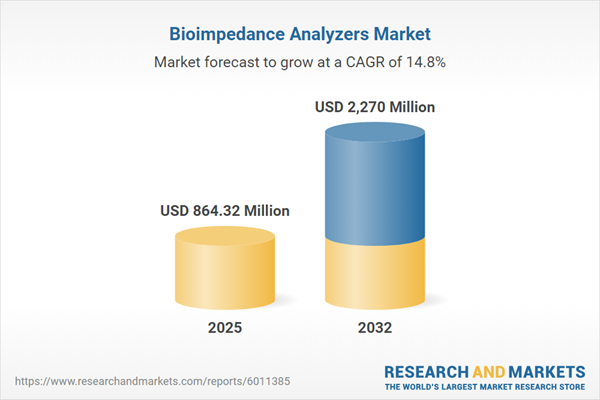Speak directly to the analyst to clarify any post sales queries you may have.
The bioimpedance analyzers market is rapidly redefining standards for healthcare organizations and research operators by providing innovative, noninvasive technologies that support efficient body composition assessment, informed resource allocation, and elevated decision-making. Senior management seeking to optimize patient care delivery and research outcomes is increasingly turning to these advanced solutions as digital health demands and operational complexity grow.
Market Snapshot: Bioimpedance Analyzers Market Overview
The global bioimpedance analyzers market is positioned for significant expansion, with market size expected to develop from USD 754.61 million in 2024 to USD 864.32 million in 2025. The trajectory continues to a forecasted USD 2.27 billion by 2032 at a CAGR of 14.78%.
Demand is fueled by the need for high-precision body composition analysis, supporting not only clinical diagnostics, but also preventive health measurement and performance assessment for athletes. Enhanced device design and evolving software platforms are improving accessibility and scalability across clinical and research applications. Healthcare organizations are adopting bioimpedance analyzers to deepen health monitoring, implement targeted care pathways, and adapt to transforming digital care environments.Scope & Segmentation in the Bioimpedance Analyzers Market
This report delivers strategic and practical insights for executive and clinical leaders by detailing foundational market segments, technology adoption paths, and international trends influencing the bioimpedance analyzers sector.
- Application: Encompasses clinical diagnostics, corporate wellness, research studies, and tailored patient care initiatives for customized health interventions.
- End User: Integrates hospitals, diagnostic labs, sports medicine providers, academic centers, and long-term care facilities, all leveraging analyzers for advanced evaluations and specialized research.
- Product Type: Offers benchtop systems for centralized laboratory settings, portable analyzers for field use and on-site diagnostics, and wearable options that support continuous, remote health monitoring.
- Technology: Employs bioelectric impedance spectroscopy, vector impedance, and single-frequency techniques, each expanding the application spectrum across both healthcare and research workflows.
- Frequency: Addresses the full measurement range from single-frequency—ideal for routine screening—to multifrequency, which enables nuanced clinical assessments.
- Region: Spans the Americas, Europe, Middle East & Africa, and Asia-Pacific, where market direction is shaped by regulatory requirements, investment priorities, and readiness for technology adoption in countries including the United States, United Kingdom, China, India, and Brazil.
- Leading Companies: Includes InBody Co., Ltd.; TANITA Corporation; Omron Healthcare Co., Ltd.; ImpediMed Limited; SECA GmbH & Co. KG; RJL Systems, Inc.; Bodystat Ltd.; Maltron International Ltd.; Akern S.r.l.; and Jawon Medical Co., Ltd., each pushing competitive differentiation through product development, technology alliances, and integrated software enhancements.
Key Takeaways for Senior Decision-Makers
- Bioimpedance analyzers empower leadership to establish tailored care models and optimize workforce deployment by providing actionable, data-driven insights.
- Seamless integration with electronic health records and telemedicine platforms helps teams collaborate more effectively, enhancing engagement and operational workflow performance.
- Artificial intelligence and advanced analytics platforms increase the specificity and value of patient outcomes and research findings.
- Continuous investment in sensor development and connectivity solutions supports operational resilience and keeps care teams coordinated in distributed settings.
- Segmenting the use of analyzers by depth of diagnostics and scope of preventive care enables executive leaders to link technology investment closely to evolving organizational strategies.
- Aligning technology with digital infrastructure and regulatory demands fosters readiness and adaptability in a shifting global landscape for healthcare delivery.
Tariff Impact on Market Landscape
- Ongoing adjustments in US tariff frameworks are driving manufacturers to redesign supply chains, focus on standardizing critical components, and strengthen cost efficiency across the industry.
- Deployment of flexible electrode and sensor solutions makes market participants more adept at managing regulatory fluctuations and international trade requirements.
Bioimpedance Analyzers Market Research Methodology & Data Sources
Research for this report draws on peer-reviewed journals, leading industry white papers, regulatory documentation, and expert consultations. This comprehensive, multi-source approach ensures reliable intelligence, actionable analysis, and practical relevance for decision-makers at the executive level.
Why This Report Matters
- Provides a clear analysis of market segmentation and competitive positioning, helping executive teams allocate research and development resources efficiently and develop informed risk strategies.
- Supports the identification of emerging partnership opportunities and strategic navigation of regulatory and technology variations in key global regions.
- Guides organizations in reconfiguring operations for greater agility and sustainable value-creation as industry conditions evolve.
Conclusion
Senior leaders will gain targeted perspectives on industry dynamics, competitive strategy, and international trends to help strengthen their position and drive digital health innovation in a maturing market.
Additional Product Information:
- Purchase of this report includes 1 year online access with quarterly updates.
- This report can be updated on request. Please contact our Customer Experience team using the Ask a Question widget on our website.
Table of Contents
3. Executive Summary
4. Market Overview
7. Cumulative Impact of Artificial Intelligence 2025
Companies Mentioned
The companies profiled in this Bioimpedance Analyzers market report include:- InBody Co., Ltd.
- TANITA Corporation
- Omron Healthcare Co., Ltd.
- ImpediMed Limited
- SECA GmbH & Co. KG
- RJL Systems, Inc.
- Bodystat Ltd.
- Maltron International Ltd.
- Akern S.r.l.
- Jawon Medical Co., Ltd.
Table Information
| Report Attribute | Details |
|---|---|
| No. of Pages | 190 |
| Published | October 2025 |
| Forecast Period | 2025 - 2032 |
| Estimated Market Value ( USD | $ 864.32 Million |
| Forecasted Market Value ( USD | $ 2270 Million |
| Compound Annual Growth Rate | 14.7% |
| Regions Covered | Global |
| No. of Companies Mentioned | 11 |









